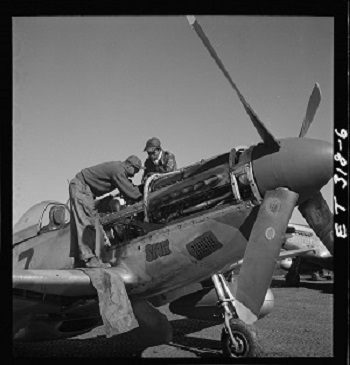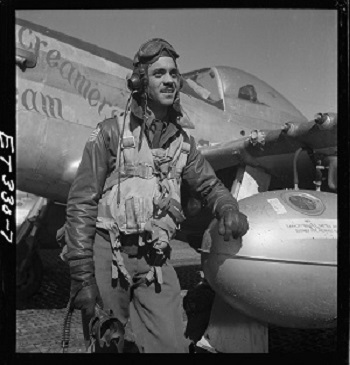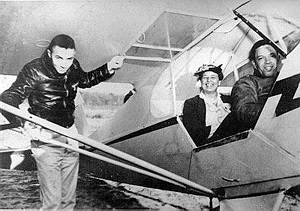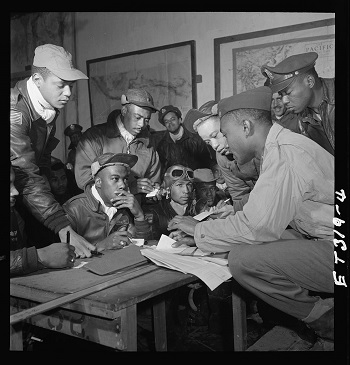Legends in Flight: Tuskegee Airmen Paved History as First African-American Military Pilots
"They have a saying that excellence is the antidote to prejudice; so once you show you can do it, some of the barriers will come down." – Dr. Roscoe Brown, Tuskegee Airman


By the time American armed forces had entered World War II, African-American soldiers had participated in every war fought within or by the United States. From the Patriot armies of the Revolutionary War to the post-Civil War peacetime units known as Buffalo Soldiers, these troops simultaneously battled enemy combatants and homeland adversity. Tenacity and bravery were hallmarks of their service.
As the contributions of black soldiers grew, so too did their desire to receive the same treatment and training as their white counterparts. Rampant inequality rose to the forefront during World War II, when African-American troops voiced a desire to become part of the Army Air Corps. This shift in dynamic eventually led to the formation of the famed Tuskegee Airmen.
Voices Unite for Change
As war erupted once again on a global scale, African-American troops found themselves in the midst of an equally vital battle in the United States. The U.S. Supreme Court’s Plessy v. Ferguson mandates of “separate but equal” and the discriminatory Jim Crow laws of the southern states did nothing to bolster the morale of black service members.
A multi-year, post-World War I study of African-American soldiers, conducted by the U.S. Army War College, greatly hindered opportunities for military desegregation and career advancement. The classified 1925 report, “The Use of Negro Manpower in War,” concluded that non-white troops lacked the moral and intellectual aptitude necessary for skilled military placement and advancement in the ranks.
With a shifting social and political landscape in America, civil rights groups took exception to segregationist policies. In 1939, the National Association for the Advancement of Colored People (NAACP) led a series of public campaigns to eradicate segregation in the armed forces. There was also a push for black troops to be accepted into the Air Corps training programs.
In January of 1941, the push took root in the legal system when civilian pilot and Howard University senior Yancey Williams filed a suit in Washington, D.C. His previous application for enlistment as a flying cadet was held because there were no suitable training units for “colored applicants.” In response to mounting pressure, the Army Air Corps created a segregated unit to train black pilots and support crews at Alabama’s Tuskegee Institute. And while it was a far cry from integration, this opportunity was a military breakthrough for black troops.
“Well, You Can Fly All Right”
Training for the Tuskegee Airmen began in 1941, with a class of 13. They trained for flight at Moton Field – the Army Air Field – and received their educations at Tuskegee University. Of the inaugural class, five completed the rigorous program. But between 1941 and 1946, roughly 1,000
African-American pilots emerged from the program.
Training such a large number of troops for combat flight was no easy feat, and it rested squarely on the shoulders of Charles Alfred “Chief” Anderson and his crew. Known today as the Father of Black Aviation, Anderson’s impressive career as a flight instructor led to his selection as head of the Tuskegee program.
In its infancy, the program received a large publicity boost when first lady Eleanor Roosevelt toured the training facilities. After discussing with Anderson the widely-believed notion that African-American troops were not good candidates for flight programs, he invited the first lady to join him on a demo flight. To the surprise of her escorts, she readily accepted. After the 40-minute flight, Roosevelt famously quoted, “Well, you can fly all right.” A photo of Anderson and Roosevelt’s flight gained momentum in newspapers around the nation. The nation quickly realized that the participants in the program had no intention of failing.

First Lady Eleanor Roosevelt had confidence in the abilitites of the young pilots.
Red Tails Go to War
Tuskegee-trained pilots, bombardiers, navigators, and support crew comprised four Air Corps fighter squadrons: the 99th, 100th, 301st, and 302nd. Together, they made up the 332nd Fighter Group. For recognition, the noses and rudders of 332nd aircraft were painted red. They would soon be known throughout various theaters of war as the “Red Tails.”
First to head overseas was the 99th Pursuit Squadron, which flew to North Africa under the command of Gen. Benjamin O. Davis – the U.S. Army’s first black general. During its first combat mission – an attack on a Mediterranean volcanic island – a garrison of more than 11,000 Italians and 78 Germans surrendered. The Red Tails’ fearlessness throughout WWII would earn them three Distinguished Unit Citations.
By 1944, the rest of the 332nd was ready to join the fight. Its primary mission was to escort bombers on strategic raids throughout Europe. Under Davis’ command, the pilots stuck with bombers, never breaking from formation to attack enemy planes. While this tactic created few aces (a fighter who shoots down at least five enemy aircraft) within the group, it gave them the distinction of losing the fewest bombers during these attacks. Soon, several allied bomber units were requesting escort from the “Red Tail Angels.”
By the end of WWII, the Tuskegee Airmen had completed approximately 1,500 missions and earned an impressive list of awards and citations, including Distinguished Flying Crosses, Purple Hearts, and the Croix de Guerre. They persevered through discrimination and gained the respect of military leaders and the aviation community. In part, their actions contributed to President Harry Truman’s Executive Order 9981, which effectively desegregated the armed forces in 1948.
Legends Live On
“You grow up feeling a love for your country in spite of its imperfections. You’re happy and proud to be an American who just happens to have a different pigmentation, a different skin color.” – Herbert Carter, Tuskegee Airman
Decades have passed since a small group of black soldiers gathered at an Alabama institution to do what people said could not be done. But the legend of the Tuskegee Airmen remains a relevant and significant chapter in the nation’s history. Their story has been immortalized many times over, including in two popular films: “The Tuskegee Airmen” starring Laurence Fishburne (1995), and George Lucas’ “Red Tails” (2012).
In March of 2007, President George W. Bush presented 300 surviving Tuskegee Airmen and family members with Congressional Gold Medals – the top civilian award given by Congress.
“Nobody, white or black, in this country can understand how God has given you so much courage,” said Rep. Charles Rangel during the award ceremony. “From a nation that had rejected you because of your color, said you couldn’t fly, said you just weren’t worthy, you had to go out there and prove to them just how wrong they were.”

